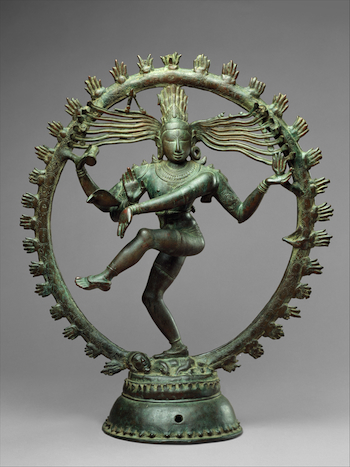To continue on with AAPI month, the next myth looks into the Hindu mythology originating God, Shiva.
Shiva is the Supreme God in Hindu mythology. He is also known as the destroyer, and has many other titles as well, such as the great ascetic (self-disciplined and free of all indulgence), great poison, great medicine, Lord of the Cattle, God of Fertility, God of Death, and God of Yoga and Meditation. Shiva is his name most often when in reference to him being the destroyer, with many other names being attributed to him depending on his form.
One of his wives is Parvati, formally Sati. He has a different number of wives depending on the text, though Parvati is consistently one of them. Parvati was a young girl when she fell for Shiva. Her father greatly disapproved of her being with him. When her father refused to invite Shiva to a huge sacrifice, she died of mortification, and was reborn as the goddess Parvati.
He is presented in multiple different ways. One depiction has him as a half-naked man with a blue face and neck, with several arms. Another has him as a man from head to waist, and women from waist to toes, with the women half depicted as Parvati. Nearly all depict him with a topknot on.
In all depictions he has three eyes with the third bestowing inward vison but with the capabilities of burning destruction when focused outward. “Shiva’s sacred Rudraksha beads and his enigmatic third eye enhance his divine persona in artistic representations,” according to Shiva Indian God: Exploring the Divine Deity of Hinduism.
In Hinduism, the Universe is said to regenerate every 2,160,000,000 years. Shiva destroys the universe at the end of each cycle, then allows for a new creation.
One of his myths is about his dance in the cosmic circle of fire (depicted with the picture). “The ring of fire that surrounds the figure is the encapsulated cosmos of mass, time, and space, whose endless cycle of annihilation and regeneration moves in tune to the beat of Shiva’s drum and the rhythm of his steps,” according to Shiva as Lord of the Dance, on Khan Academy.
Shiva’s hair, the hair of the yogi (supporter of yoga, which is known as Hinduism’s gift to humanity), spans across the space in the halo of fire that constitutes the universe. Throughout the whole process of chaos and renewal, Shiva’s face remains calm, transfixed in what Heinrich Zimmer, historian of South Asian art calls “the mask of god’s eternal essence.”
Shaivism is a popular Hindu sect devoted to the worship of Shiva, and holds a significant place in India, with its own unique beliefs, rituals, and practices. People who are part of this are called Shaivites. They practice a lifestyle called asceticism, in which they practice self-discipline, as well as control over physical and mental desires. They also practice in fasting, meditation, and self-denial in order to achieve a deeper understanding of the divine.
They mark themselves with 3 lines on their foreheads, called the Tripundra. The represent the 3 fundamentals of Shiva: preservation (Vishnu), creation (Brahma), and destruction (Shiva). They do this as a reminder to balance these forces within themselves, as well as to remember the interconnected nature of the cosmos.
Through looking at Shiva’s calmness, it can be learned to have patience despite what goes on around you, and to stay calm even in the most destressing of situations. In art, even if what you’re working on at the time feels like it’s majorly diverting from where you had initially wanted it to go, don’t panic. By getting through it, it’s possible that, though different from what you had expected, something that’s still great can be created.













